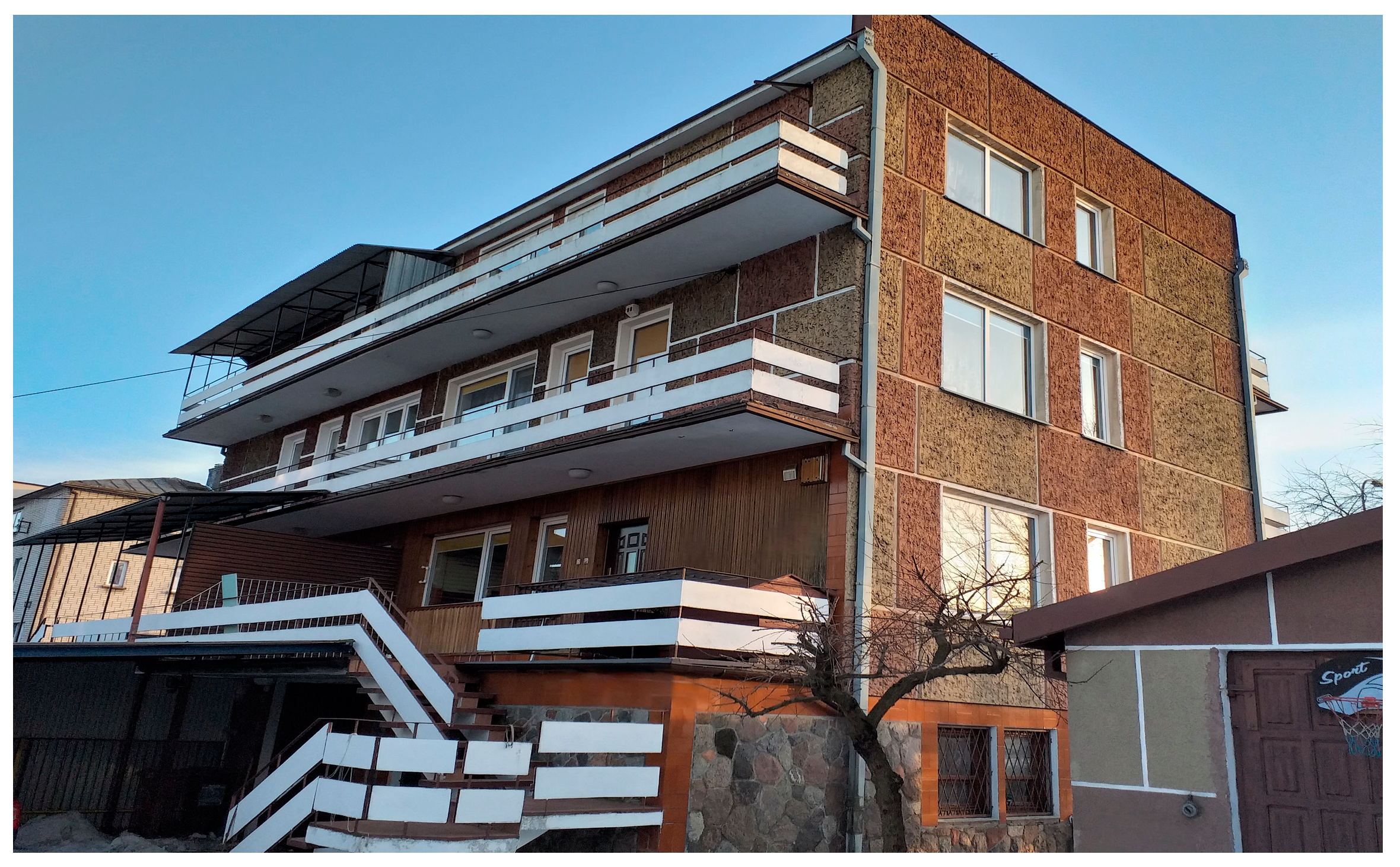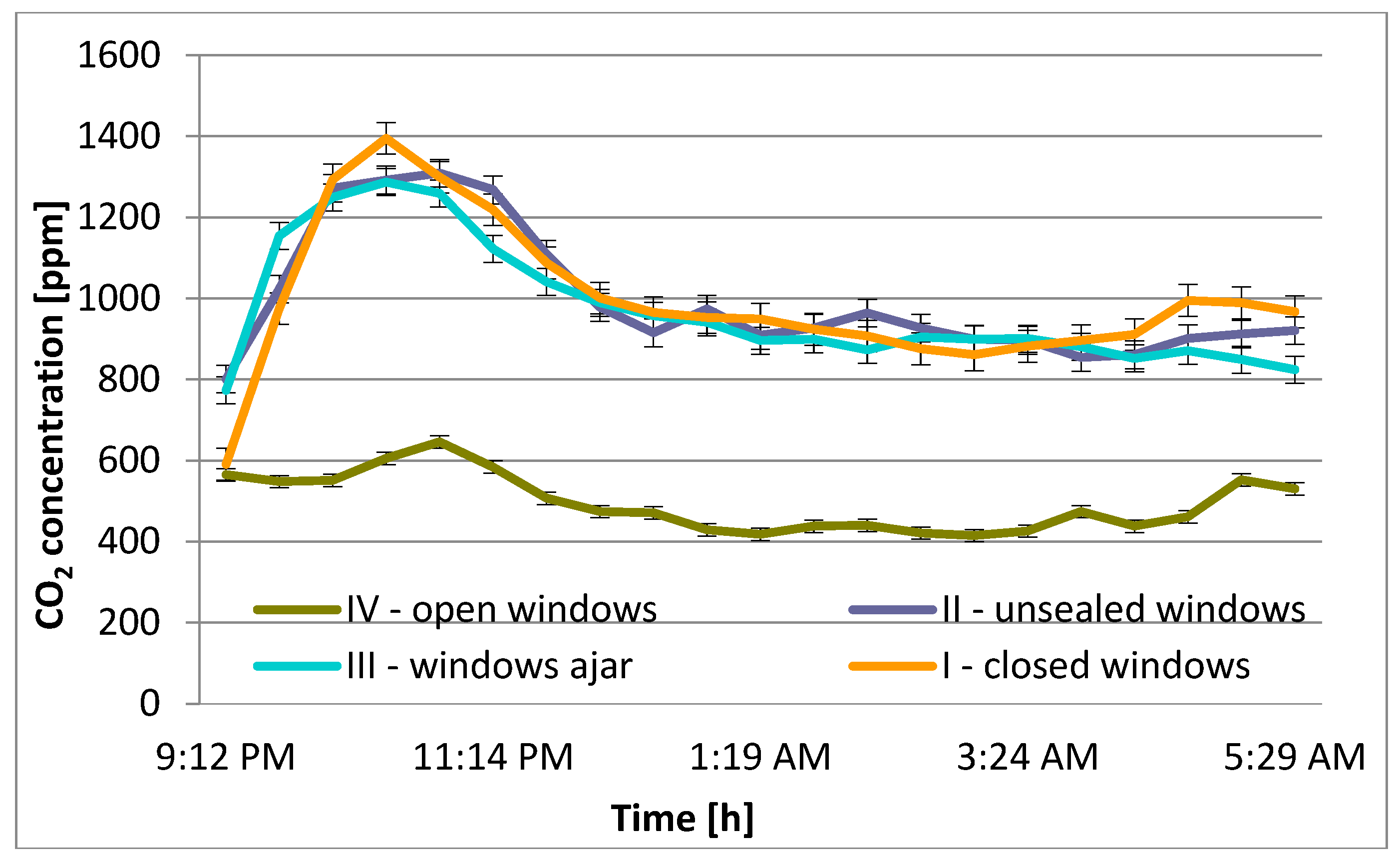Indoor Air Quality in the Bedroom of a Single-Family House—A Case Study †
Abstract
:1. Introduction
2. Materials and Methods
3. Results
4. Discussion
5. Conclusions
Acknowledgments
Conflicts of Interest
References
- ASHRAE. Standard 62-1989, Ventilation for acceptable Indoor Air Quality; ASHRAE: Atlanta, GA, USA, 1989. [Google Scholar]
- ASHRAE. Thermal Environmental Conditions for Human Occupancy ANSI/ASHRAE Standard; ASHRAE: Atlanta, GA, USA, 2013. [Google Scholar]
- ASH American Society of Heating. Refrigerating and Air-Conditioning Engineers—Guidelines for Design and Constructions of Health Care Facilities; ASH American Society of Heating: Atlanta, GA, USA, 2006. [Google Scholar]
- PN-EN 13779:2008 Ventilation of residential buildings. Requirements for the properties of ventilation and air conditioning.
- WHO. Air Quality Guidelines for Europe, 2nd ed.; European Series, No. 91; WHO Regional Office for Europe Copenhagen: København, Danmark, 2000. [Google Scholar]
- Chludzinska, M.; Bogdan, A. The effect of temperature and direction of airflow from the personalised ventilation on occupants’ thermal sensations in office areas. Build. Environ. 2015, 85, 277–286. [Google Scholar] [CrossRef]
- Gładyszewska-Fiedoruk, K. Correlation of humidity and temperature in conference rooms—Preliminary tests. E3S Web Conf. 2018, 49, 00032. [Google Scholar] [CrossRef]
- Uścinowicz, P.; Chludzinska, M.; Bogdan, A. Thermal environment conditions in Polish operating rooms. Build. Environ. 2015, 94, 296–304. [Google Scholar] [CrossRef]
- Bekö, G.; Lund, T.; Nors, F.; Toftum, J.; Clausen, G. Ventilation rates in the bedrooms of 500 Danish children. Build. Environ. 2010, 45, 2289–2295. [Google Scholar] [CrossRef]
- Brągoszewska, E.; Biedroń, I. Indoor Air Quality and Potential Health Risk Impacts of Exposure to Antibiotic Resistant Bacteria in an Office Rooms in Southern Poland. Int. J. Environ. Res. Public Health 2018, 15, 2604. [Google Scholar] [CrossRef] [PubMed]
- Lan, L.; Pan, L.; Lian, Z.; Huang, H.; Lin, Y. Experimental study on thermal comfort of sleeping people at different air temperatures. Build. Environ. 2014, 73, 24–31. [Google Scholar] [CrossRef]
- Molina, F.Q.; Yaguana, D.B. Indoor Environmental Quality of Urban Residential Buildings in Cuenca—Ecuador: Comfort Standard. Buildings 2018, 8, 90. [Google Scholar] [CrossRef]
- Sekhar, S.C.; Goh, S.E. Thermal comfort and IAQ characteristics of naturally/mechanically ventilated and air-conditioned bedrooms in a hot and humid climate. Build. and Environ. 2011, 46, 1905–1916. [Google Scholar] [CrossRef]
- Verhaeghe, G. Self-Portrait in Bed. A Case Study of Carlo Mollino’s ‘Bedroom for a Farmhouse in the Rice Fields’. 2017, 1, 894. [Google Scholar] [CrossRef]
- Wong, N.H.; Huang, B. Comparative study of the indoor air quality of naturally ventilated and airconditioned bedrooms of residential building in Singapore. Build. Environ. 2004, 39, 1115–1123. [Google Scholar] [CrossRef]
- Lin, Z.; Deng, S. A questionnaire survey on sleeping thermal environment and bedroom air conditioning in high-rise residences in Hong Kong. Energy Build. 2006, 38, 1302–1307. [Google Scholar] [CrossRef]
- Gładyszewska-Fiedoruk, K.; Jachimowicz, S. Analysis of carbon dioxide in Kindergartens in Poland. In Proceedings of the 10th International Conference Environmental Engineering, Vilnius, Lithuania, 27–28 April 2017. [Google Scholar] [CrossRef]
- Teleszewski, T.J. Experimental investigation of the kinetic energy correction factor in pipe flow, E3S. Web Conf. 2018, 44, 00177. [Google Scholar] [CrossRef]
- Teleszewski, T.J.; Sorko, S.A. Effect of viscous dissipation on forced convection for laminar flow through a straight regular polygonal duct using BEM method. Int. J. Numeri. Methods Heat Fluid Flow 2018, 28, 220–238. [Google Scholar] [CrossRef]
- Alfelali, M.; Khandaker, G. Infectious causes of sudden infant death syndrome. Pediatric Respir. Rev. 2014, 15, 307–311. [Google Scholar] [CrossRef] [PubMed]


Publisher’s Note: MDPI stays neutral with regard to jurisdictional claims in published maps and institutional affiliations. |
© 2019 by the author. Licensee MDPI, Basel, Switzerland. This article is an open access article distributed under the terms and conditions of the Creative Commons Attribution (CC BY) license (https://creativecommons.org/licenses/by/4.0/).
Share and Cite
Gładyszewska-Fiedoruk, K. Indoor Air Quality in the Bedroom of a Single-Family House—A Case Study. Proceedings 2019, 16, 38. https://doi.org/10.3390/proceedings2019016038
Gładyszewska-Fiedoruk K. Indoor Air Quality in the Bedroom of a Single-Family House—A Case Study. Proceedings. 2019; 16(1):38. https://doi.org/10.3390/proceedings2019016038
Chicago/Turabian StyleGładyszewska-Fiedoruk, Katarzyna. 2019. "Indoor Air Quality in the Bedroom of a Single-Family House—A Case Study" Proceedings 16, no. 1: 38. https://doi.org/10.3390/proceedings2019016038
APA StyleGładyszewska-Fiedoruk, K. (2019). Indoor Air Quality in the Bedroom of a Single-Family House—A Case Study. Proceedings, 16(1), 38. https://doi.org/10.3390/proceedings2019016038




